Public Health 11: Human Rights Analysis of Women's Health Policy
VerifiedAdded on 2020/03/16
|15
|4507
|59
Report
AI Summary
This report provides a human rights analysis of the National Women's Health Policy 2010 implemented in Australia to address the health challenges faced by women. It evaluates the policy based on a seven-stage human rights approach, examining its intended purpose, impact on health, and influence on human rights elements like gender and health equity. The report highlights the policy's focus on preventing chronic diseases, promoting mental health, and addressing health inequities, particularly among vulnerable groups such as Aboriginal and Torres Strait Islander women. It discusses the positive impacts of the policy, such as improving social determinants of health and employing a life course approach, while also acknowledging limitations like the impact of interventions on health behavior and the need for a broad-based approach to consider health impact for women living in poor socioeconomic conditions. The report also examines the policy's role in addressing gender equity and the restrictions of human rights, emphasizing the need for continued improvements in areas like women's access to housing, property and their contribution to parenting responsibilities.
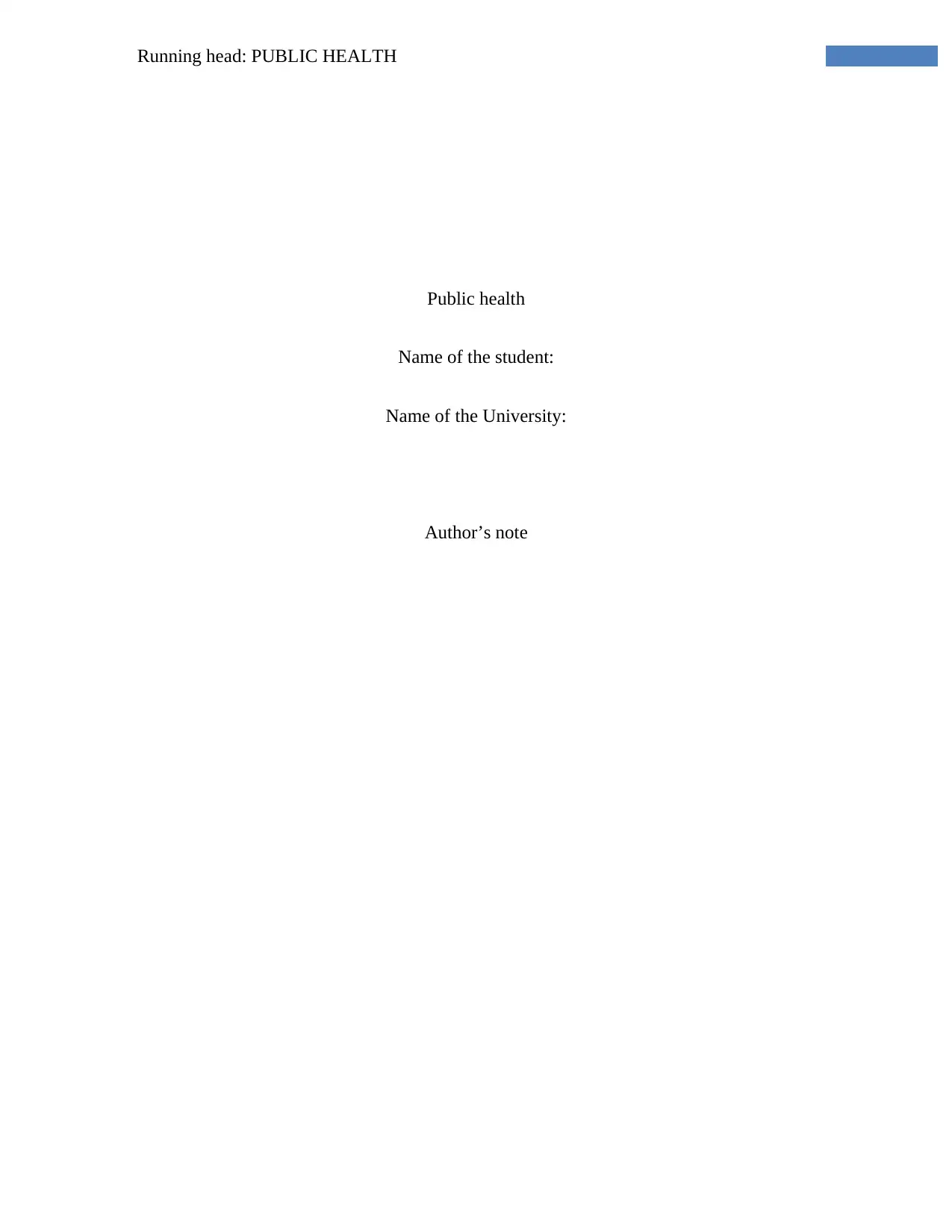
Running head: PUBLIC HEALTH
Public health
Name of the student:
Name of the University:
Author’s note
Public health
Name of the student:
Name of the University:
Author’s note
Paraphrase This Document
Need a fresh take? Get an instant paraphrase of this document with our AI Paraphraser
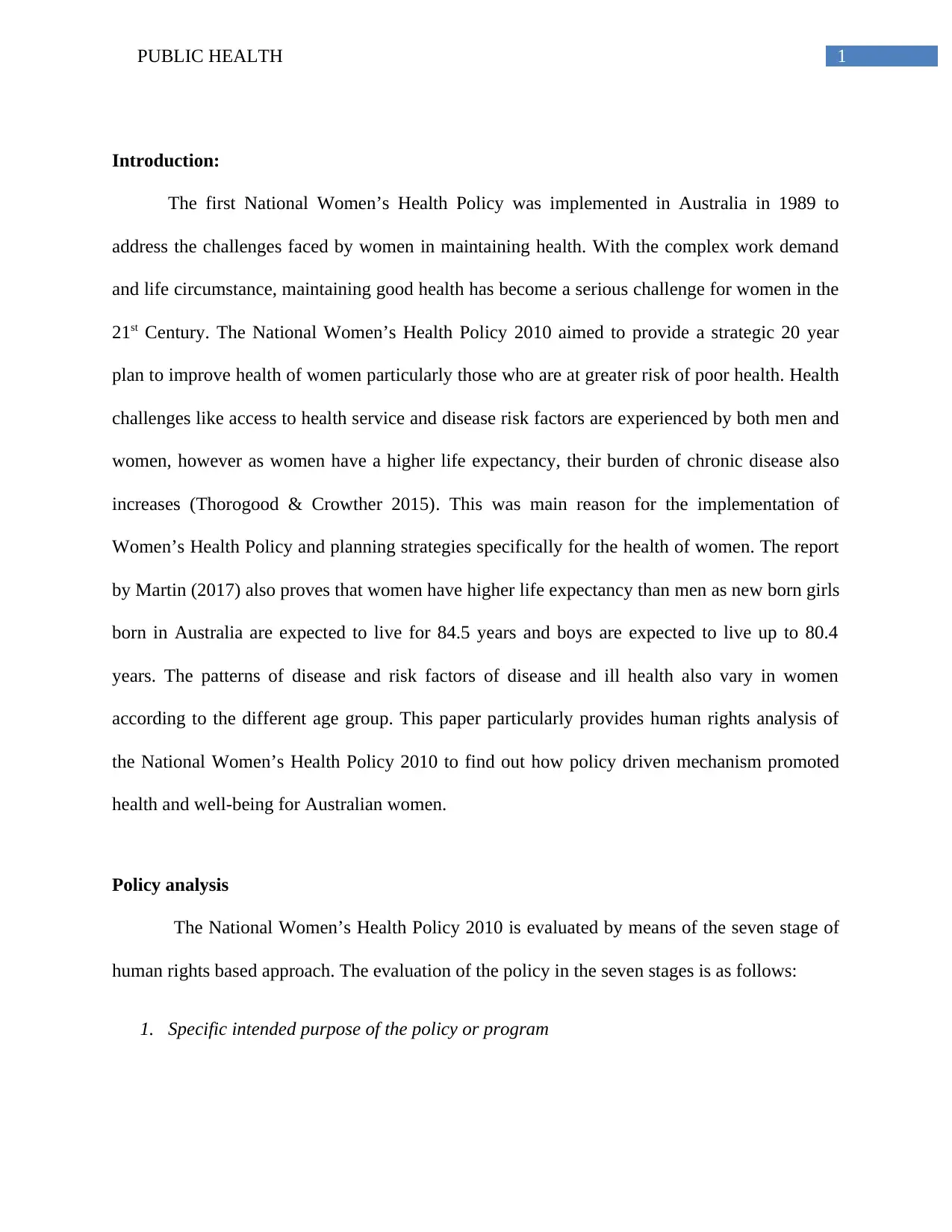
1PUBLIC HEALTH
Introduction:
The first National Women’s Health Policy was implemented in Australia in 1989 to
address the challenges faced by women in maintaining health. With the complex work demand
and life circumstance, maintaining good health has become a serious challenge for women in the
21st Century. The National Women’s Health Policy 2010 aimed to provide a strategic 20 year
plan to improve health of women particularly those who are at greater risk of poor health. Health
challenges like access to health service and disease risk factors are experienced by both men and
women, however as women have a higher life expectancy, their burden of chronic disease also
increases (Thorogood & Crowther 2015). This was main reason for the implementation of
Women’s Health Policy and planning strategies specifically for the health of women. The report
by Martin (2017) also proves that women have higher life expectancy than men as new born girls
born in Australia are expected to live for 84.5 years and boys are expected to live up to 80.4
years. The patterns of disease and risk factors of disease and ill health also vary in women
according to the different age group. This paper particularly provides human rights analysis of
the National Women’s Health Policy 2010 to find out how policy driven mechanism promoted
health and well-being for Australian women.
Policy analysis
The National Women’s Health Policy 2010 is evaluated by means of the seven stage of
human rights based approach. The evaluation of the policy in the seven stages is as follows:
1. Specific intended purpose of the policy or program
Introduction:
The first National Women’s Health Policy was implemented in Australia in 1989 to
address the challenges faced by women in maintaining health. With the complex work demand
and life circumstance, maintaining good health has become a serious challenge for women in the
21st Century. The National Women’s Health Policy 2010 aimed to provide a strategic 20 year
plan to improve health of women particularly those who are at greater risk of poor health. Health
challenges like access to health service and disease risk factors are experienced by both men and
women, however as women have a higher life expectancy, their burden of chronic disease also
increases (Thorogood & Crowther 2015). This was main reason for the implementation of
Women’s Health Policy and planning strategies specifically for the health of women. The report
by Martin (2017) also proves that women have higher life expectancy than men as new born girls
born in Australia are expected to live for 84.5 years and boys are expected to live up to 80.4
years. The patterns of disease and risk factors of disease and ill health also vary in women
according to the different age group. This paper particularly provides human rights analysis of
the National Women’s Health Policy 2010 to find out how policy driven mechanism promoted
health and well-being for Australian women.
Policy analysis
The National Women’s Health Policy 2010 is evaluated by means of the seven stage of
human rights based approach. The evaluation of the policy in the seven stages is as follows:
1. Specific intended purpose of the policy or program
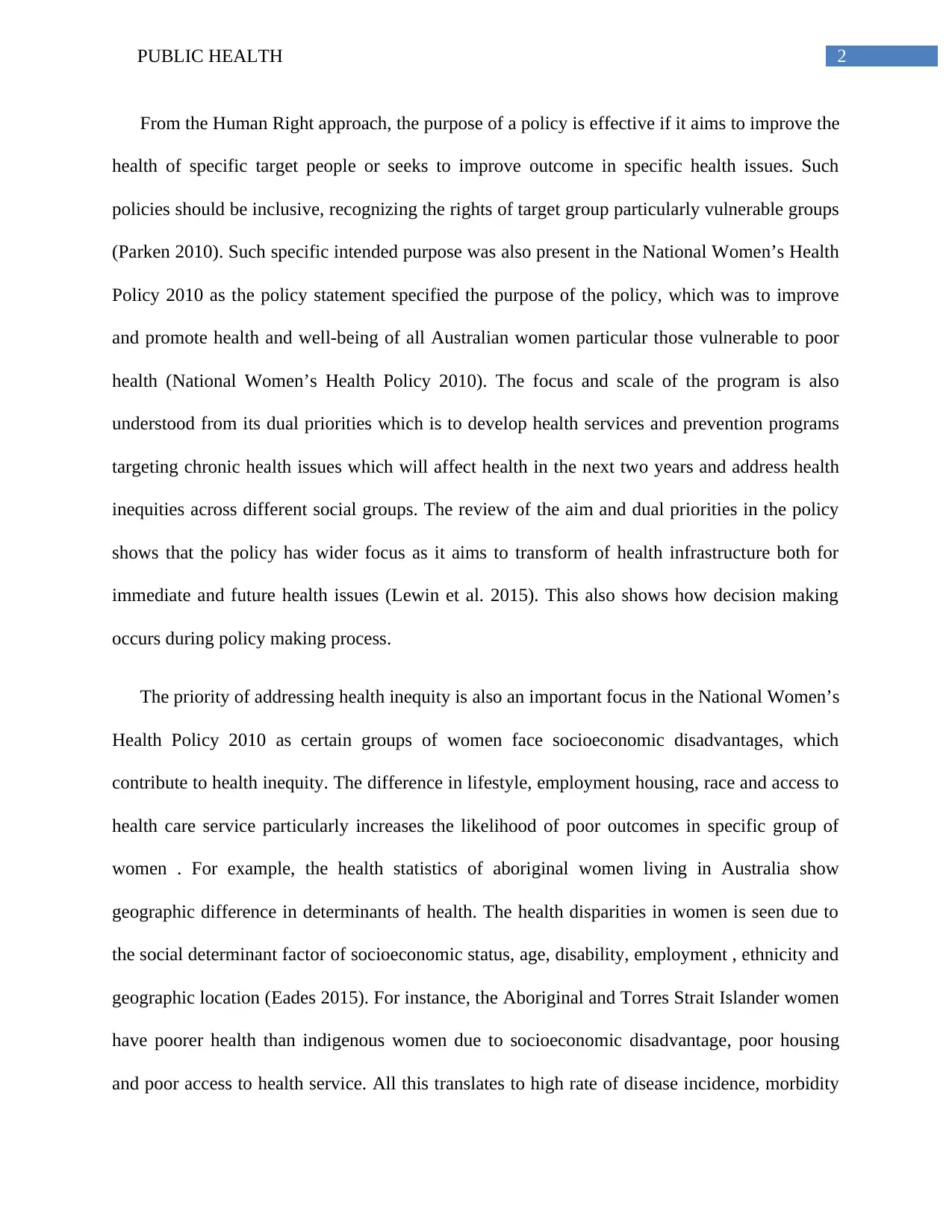
2PUBLIC HEALTH
From the Human Right approach, the purpose of a policy is effective if it aims to improve the
health of specific target people or seeks to improve outcome in specific health issues. Such
policies should be inclusive, recognizing the rights of target group particularly vulnerable groups
(Parken 2010). Such specific intended purpose was also present in the National Women’s Health
Policy 2010 as the policy statement specified the purpose of the policy, which was to improve
and promote health and well-being of all Australian women particular those vulnerable to poor
health (National Women’s Health Policy 2010). The focus and scale of the program is also
understood from its dual priorities which is to develop health services and prevention programs
targeting chronic health issues which will affect health in the next two years and address health
inequities across different social groups. The review of the aim and dual priorities in the policy
shows that the policy has wider focus as it aims to transform of health infrastructure both for
immediate and future health issues (Lewin et al. 2015). This also shows how decision making
occurs during policy making process.
The priority of addressing health inequity is also an important focus in the National Women’s
Health Policy 2010 as certain groups of women face socioeconomic disadvantages, which
contribute to health inequity. The difference in lifestyle, employment housing, race and access to
health care service particularly increases the likelihood of poor outcomes in specific group of
women . For example, the health statistics of aboriginal women living in Australia show
geographic difference in determinants of health. The health disparities in women is seen due to
the social determinant factor of socioeconomic status, age, disability, employment , ethnicity and
geographic location (Eades 2015). For instance, the Aboriginal and Torres Strait Islander women
have poorer health than indigenous women due to socioeconomic disadvantage, poor housing
and poor access to health service. All this translates to high rate of disease incidence, morbidity
From the Human Right approach, the purpose of a policy is effective if it aims to improve the
health of specific target people or seeks to improve outcome in specific health issues. Such
policies should be inclusive, recognizing the rights of target group particularly vulnerable groups
(Parken 2010). Such specific intended purpose was also present in the National Women’s Health
Policy 2010 as the policy statement specified the purpose of the policy, which was to improve
and promote health and well-being of all Australian women particular those vulnerable to poor
health (National Women’s Health Policy 2010). The focus and scale of the program is also
understood from its dual priorities which is to develop health services and prevention programs
targeting chronic health issues which will affect health in the next two years and address health
inequities across different social groups. The review of the aim and dual priorities in the policy
shows that the policy has wider focus as it aims to transform of health infrastructure both for
immediate and future health issues (Lewin et al. 2015). This also shows how decision making
occurs during policy making process.
The priority of addressing health inequity is also an important focus in the National Women’s
Health Policy 2010 as certain groups of women face socioeconomic disadvantages, which
contribute to health inequity. The difference in lifestyle, employment housing, race and access to
health care service particularly increases the likelihood of poor outcomes in specific group of
women . For example, the health statistics of aboriginal women living in Australia show
geographic difference in determinants of health. The health disparities in women is seen due to
the social determinant factor of socioeconomic status, age, disability, employment , ethnicity and
geographic location (Eades 2015). For instance, the Aboriginal and Torres Strait Islander women
have poorer health than indigenous women due to socioeconomic disadvantage, poor housing
and poor access to health service. All this translates to high rate of disease incidence, morbidity
⊘ This is a preview!⊘
Do you want full access?
Subscribe today to unlock all pages.

Trusted by 1+ million students worldwide
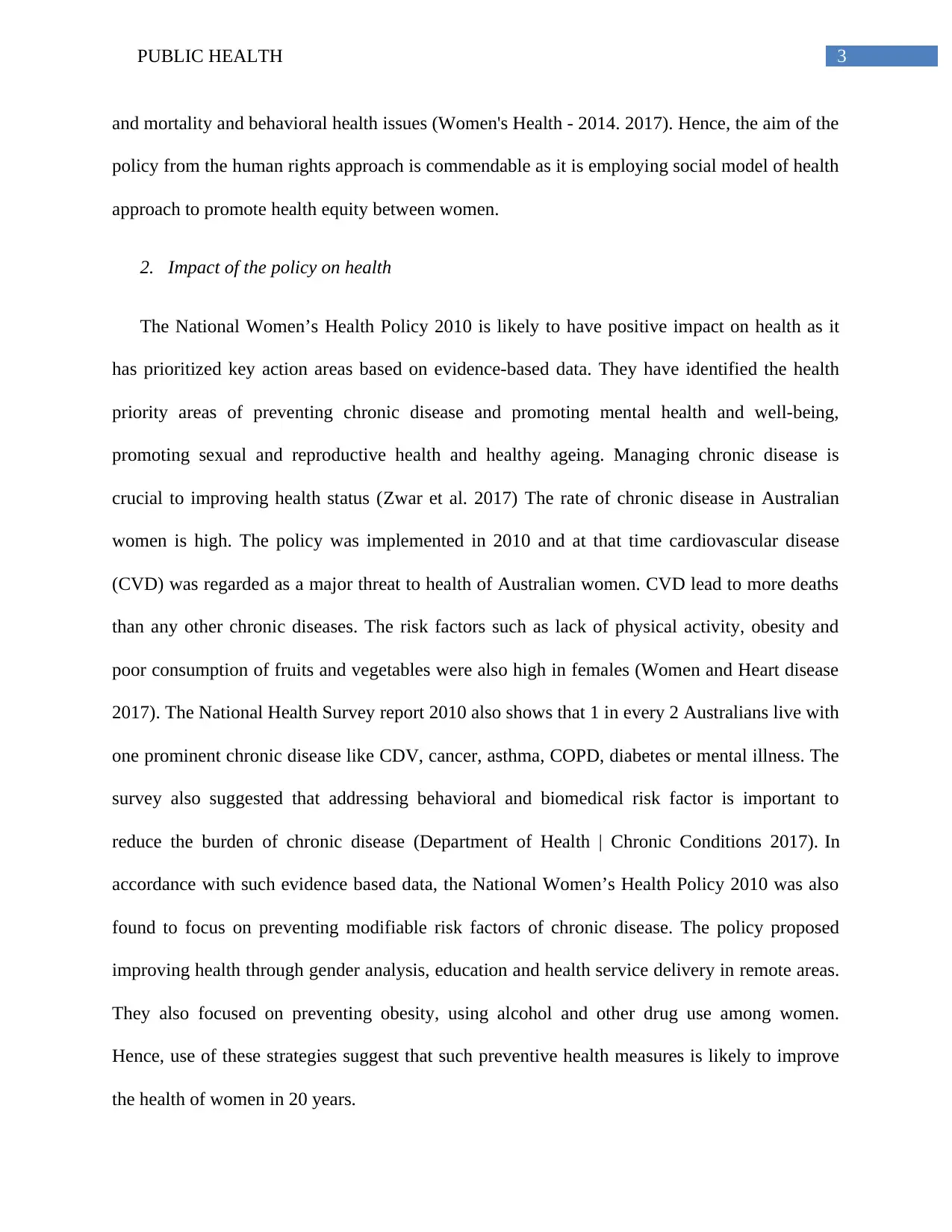
3PUBLIC HEALTH
and mortality and behavioral health issues (Women's Health - 2014. 2017). Hence, the aim of the
policy from the human rights approach is commendable as it is employing social model of health
approach to promote health equity between women.
2. Impact of the policy on health
The National Women’s Health Policy 2010 is likely to have positive impact on health as it
has prioritized key action areas based on evidence-based data. They have identified the health
priority areas of preventing chronic disease and promoting mental health and well-being,
promoting sexual and reproductive health and healthy ageing. Managing chronic disease is
crucial to improving health status (Zwar et al. 2017) The rate of chronic disease in Australian
women is high. The policy was implemented in 2010 and at that time cardiovascular disease
(CVD) was regarded as a major threat to health of Australian women. CVD lead to more deaths
than any other chronic diseases. The risk factors such as lack of physical activity, obesity and
poor consumption of fruits and vegetables were also high in females (Women and Heart disease
2017). The National Health Survey report 2010 also shows that 1 in every 2 Australians live with
one prominent chronic disease like CDV, cancer, asthma, COPD, diabetes or mental illness. The
survey also suggested that addressing behavioral and biomedical risk factor is important to
reduce the burden of chronic disease (Department of Health | Chronic Conditions 2017). In
accordance with such evidence based data, the National Women’s Health Policy 2010 was also
found to focus on preventing modifiable risk factors of chronic disease. The policy proposed
improving health through gender analysis, education and health service delivery in remote areas.
They also focused on preventing obesity, using alcohol and other drug use among women.
Hence, use of these strategies suggest that such preventive health measures is likely to improve
the health of women in 20 years.
and mortality and behavioral health issues (Women's Health - 2014. 2017). Hence, the aim of the
policy from the human rights approach is commendable as it is employing social model of health
approach to promote health equity between women.
2. Impact of the policy on health
The National Women’s Health Policy 2010 is likely to have positive impact on health as it
has prioritized key action areas based on evidence-based data. They have identified the health
priority areas of preventing chronic disease and promoting mental health and well-being,
promoting sexual and reproductive health and healthy ageing. Managing chronic disease is
crucial to improving health status (Zwar et al. 2017) The rate of chronic disease in Australian
women is high. The policy was implemented in 2010 and at that time cardiovascular disease
(CVD) was regarded as a major threat to health of Australian women. CVD lead to more deaths
than any other chronic diseases. The risk factors such as lack of physical activity, obesity and
poor consumption of fruits and vegetables were also high in females (Women and Heart disease
2017). The National Health Survey report 2010 also shows that 1 in every 2 Australians live with
one prominent chronic disease like CDV, cancer, asthma, COPD, diabetes or mental illness. The
survey also suggested that addressing behavioral and biomedical risk factor is important to
reduce the burden of chronic disease (Department of Health | Chronic Conditions 2017). In
accordance with such evidence based data, the National Women’s Health Policy 2010 was also
found to focus on preventing modifiable risk factors of chronic disease. The policy proposed
improving health through gender analysis, education and health service delivery in remote areas.
They also focused on preventing obesity, using alcohol and other drug use among women.
Hence, use of these strategies suggest that such preventive health measures is likely to improve
the health of women in 20 years.
Paraphrase This Document
Need a fresh take? Get an instant paraphrase of this document with our AI Paraphraser
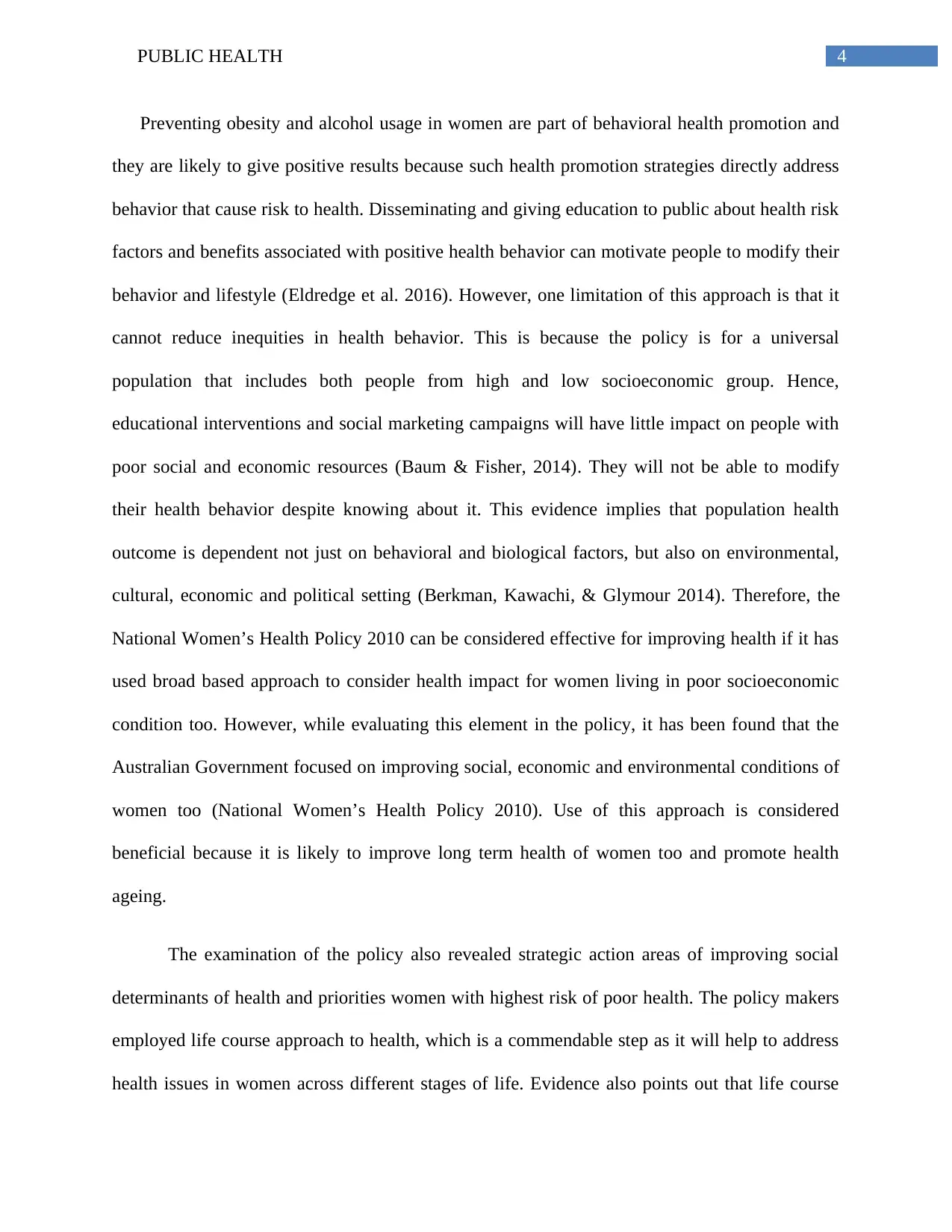
4PUBLIC HEALTH
Preventing obesity and alcohol usage in women are part of behavioral health promotion and
they are likely to give positive results because such health promotion strategies directly address
behavior that cause risk to health. Disseminating and giving education to public about health risk
factors and benefits associated with positive health behavior can motivate people to modify their
behavior and lifestyle (Eldredge et al. 2016). However, one limitation of this approach is that it
cannot reduce inequities in health behavior. This is because the policy is for a universal
population that includes both people from high and low socioeconomic group. Hence,
educational interventions and social marketing campaigns will have little impact on people with
poor social and economic resources (Baum & Fisher, 2014). They will not be able to modify
their health behavior despite knowing about it. This evidence implies that population health
outcome is dependent not just on behavioral and biological factors, but also on environmental,
cultural, economic and political setting (Berkman, Kawachi, & Glymour 2014). Therefore, the
National Women’s Health Policy 2010 can be considered effective for improving health if it has
used broad based approach to consider health impact for women living in poor socioeconomic
condition too. However, while evaluating this element in the policy, it has been found that the
Australian Government focused on improving social, economic and environmental conditions of
women too (National Women’s Health Policy 2010). Use of this approach is considered
beneficial because it is likely to improve long term health of women too and promote health
ageing.
The examination of the policy also revealed strategic action areas of improving social
determinants of health and priorities women with highest risk of poor health. The policy makers
employed life course approach to health, which is a commendable step as it will help to address
health issues in women across different stages of life. Evidence also points out that life course
Preventing obesity and alcohol usage in women are part of behavioral health promotion and
they are likely to give positive results because such health promotion strategies directly address
behavior that cause risk to health. Disseminating and giving education to public about health risk
factors and benefits associated with positive health behavior can motivate people to modify their
behavior and lifestyle (Eldredge et al. 2016). However, one limitation of this approach is that it
cannot reduce inequities in health behavior. This is because the policy is for a universal
population that includes both people from high and low socioeconomic group. Hence,
educational interventions and social marketing campaigns will have little impact on people with
poor social and economic resources (Baum & Fisher, 2014). They will not be able to modify
their health behavior despite knowing about it. This evidence implies that population health
outcome is dependent not just on behavioral and biological factors, but also on environmental,
cultural, economic and political setting (Berkman, Kawachi, & Glymour 2014). Therefore, the
National Women’s Health Policy 2010 can be considered effective for improving health if it has
used broad based approach to consider health impact for women living in poor socioeconomic
condition too. However, while evaluating this element in the policy, it has been found that the
Australian Government focused on improving social, economic and environmental conditions of
women too (National Women’s Health Policy 2010). Use of this approach is considered
beneficial because it is likely to improve long term health of women too and promote health
ageing.
The examination of the policy also revealed strategic action areas of improving social
determinants of health and priorities women with highest risk of poor health. The policy makers
employed life course approach to health, which is a commendable step as it will help to address
health issues in women across different stages of life. Evidence also points out that life course
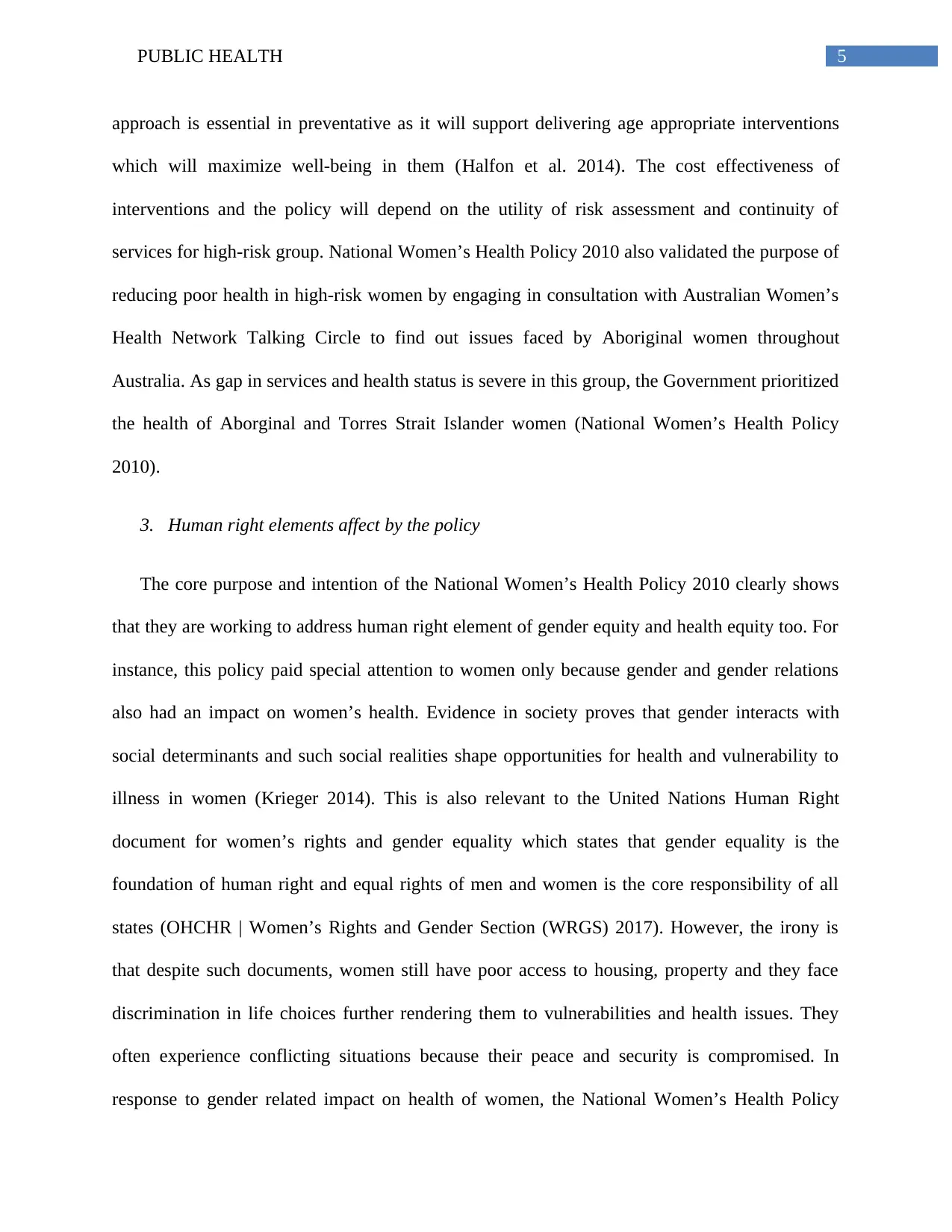
5PUBLIC HEALTH
approach is essential in preventative as it will support delivering age appropriate interventions
which will maximize well-being in them (Halfon et al. 2014). The cost effectiveness of
interventions and the policy will depend on the utility of risk assessment and continuity of
services for high-risk group. National Women’s Health Policy 2010 also validated the purpose of
reducing poor health in high-risk women by engaging in consultation with Australian Women’s
Health Network Talking Circle to find out issues faced by Aboriginal women throughout
Australia. As gap in services and health status is severe in this group, the Government prioritized
the health of Aborginal and Torres Strait Islander women (National Women’s Health Policy
2010).
3. Human right elements affect by the policy
The core purpose and intention of the National Women’s Health Policy 2010 clearly shows
that they are working to address human right element of gender equity and health equity too. For
instance, this policy paid special attention to women only because gender and gender relations
also had an impact on women’s health. Evidence in society proves that gender interacts with
social determinants and such social realities shape opportunities for health and vulnerability to
illness in women (Krieger 2014). This is also relevant to the United Nations Human Right
document for women’s rights and gender equality which states that gender equality is the
foundation of human right and equal rights of men and women is the core responsibility of all
states (OHCHR | Women’s Rights and Gender Section (WRGS) 2017). However, the irony is
that despite such documents, women still have poor access to housing, property and they face
discrimination in life choices further rendering them to vulnerabilities and health issues. They
often experience conflicting situations because their peace and security is compromised. In
response to gender related impact on health of women, the National Women’s Health Policy
approach is essential in preventative as it will support delivering age appropriate interventions
which will maximize well-being in them (Halfon et al. 2014). The cost effectiveness of
interventions and the policy will depend on the utility of risk assessment and continuity of
services for high-risk group. National Women’s Health Policy 2010 also validated the purpose of
reducing poor health in high-risk women by engaging in consultation with Australian Women’s
Health Network Talking Circle to find out issues faced by Aboriginal women throughout
Australia. As gap in services and health status is severe in this group, the Government prioritized
the health of Aborginal and Torres Strait Islander women (National Women’s Health Policy
2010).
3. Human right elements affect by the policy
The core purpose and intention of the National Women’s Health Policy 2010 clearly shows
that they are working to address human right element of gender equity and health equity too. For
instance, this policy paid special attention to women only because gender and gender relations
also had an impact on women’s health. Evidence in society proves that gender interacts with
social determinants and such social realities shape opportunities for health and vulnerability to
illness in women (Krieger 2014). This is also relevant to the United Nations Human Right
document for women’s rights and gender equality which states that gender equality is the
foundation of human right and equal rights of men and women is the core responsibility of all
states (OHCHR | Women’s Rights and Gender Section (WRGS) 2017). However, the irony is
that despite such documents, women still have poor access to housing, property and they face
discrimination in life choices further rendering them to vulnerabilities and health issues. They
often experience conflicting situations because their peace and security is compromised. In
response to gender related impact on health of women, the National Women’s Health Policy
⊘ This is a preview!⊘
Do you want full access?
Subscribe today to unlock all pages.

Trusted by 1+ million students worldwide
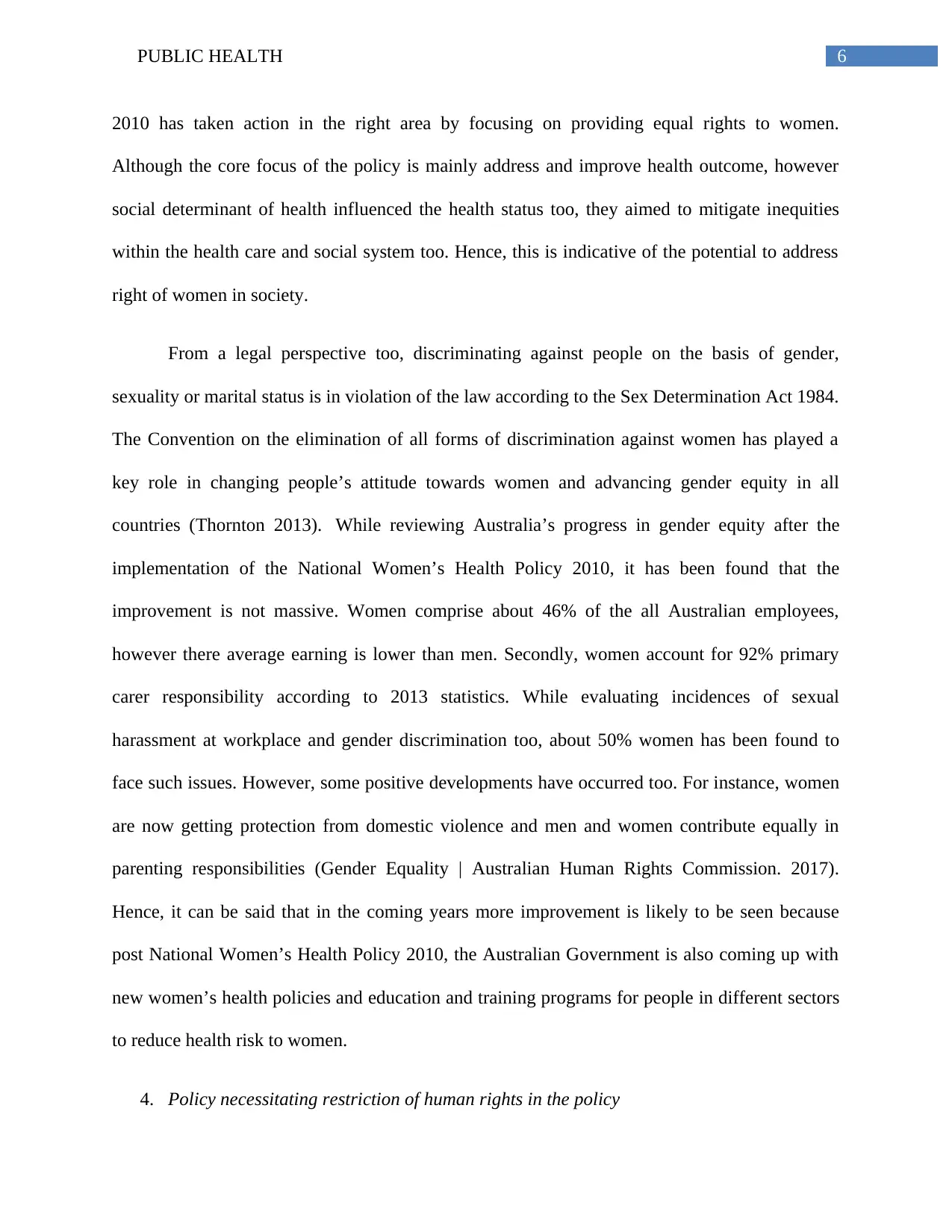
6PUBLIC HEALTH
2010 has taken action in the right area by focusing on providing equal rights to women.
Although the core focus of the policy is mainly address and improve health outcome, however
social determinant of health influenced the health status too, they aimed to mitigate inequities
within the health care and social system too. Hence, this is indicative of the potential to address
right of women in society.
From a legal perspective too, discriminating against people on the basis of gender,
sexuality or marital status is in violation of the law according to the Sex Determination Act 1984.
The Convention on the elimination of all forms of discrimination against women has played a
key role in changing people’s attitude towards women and advancing gender equity in all
countries (Thornton 2013). While reviewing Australia’s progress in gender equity after the
implementation of the National Women’s Health Policy 2010, it has been found that the
improvement is not massive. Women comprise about 46% of the all Australian employees,
however there average earning is lower than men. Secondly, women account for 92% primary
carer responsibility according to 2013 statistics. While evaluating incidences of sexual
harassment at workplace and gender discrimination too, about 50% women has been found to
face such issues. However, some positive developments have occurred too. For instance, women
are now getting protection from domestic violence and men and women contribute equally in
parenting responsibilities (Gender Equality | Australian Human Rights Commission. 2017).
Hence, it can be said that in the coming years more improvement is likely to be seen because
post National Women’s Health Policy 2010, the Australian Government is also coming up with
new women’s health policies and education and training programs for people in different sectors
to reduce health risk to women.
4. Policy necessitating restriction of human rights in the policy
2010 has taken action in the right area by focusing on providing equal rights to women.
Although the core focus of the policy is mainly address and improve health outcome, however
social determinant of health influenced the health status too, they aimed to mitigate inequities
within the health care and social system too. Hence, this is indicative of the potential to address
right of women in society.
From a legal perspective too, discriminating against people on the basis of gender,
sexuality or marital status is in violation of the law according to the Sex Determination Act 1984.
The Convention on the elimination of all forms of discrimination against women has played a
key role in changing people’s attitude towards women and advancing gender equity in all
countries (Thornton 2013). While reviewing Australia’s progress in gender equity after the
implementation of the National Women’s Health Policy 2010, it has been found that the
improvement is not massive. Women comprise about 46% of the all Australian employees,
however there average earning is lower than men. Secondly, women account for 92% primary
carer responsibility according to 2013 statistics. While evaluating incidences of sexual
harassment at workplace and gender discrimination too, about 50% women has been found to
face such issues. However, some positive developments have occurred too. For instance, women
are now getting protection from domestic violence and men and women contribute equally in
parenting responsibilities (Gender Equality | Australian Human Rights Commission. 2017).
Hence, it can be said that in the coming years more improvement is likely to be seen because
post National Women’s Health Policy 2010, the Australian Government is also coming up with
new women’s health policies and education and training programs for people in different sectors
to reduce health risk to women.
4. Policy necessitating restriction of human rights in the policy
Paraphrase This Document
Need a fresh take? Get an instant paraphrase of this document with our AI Paraphraser
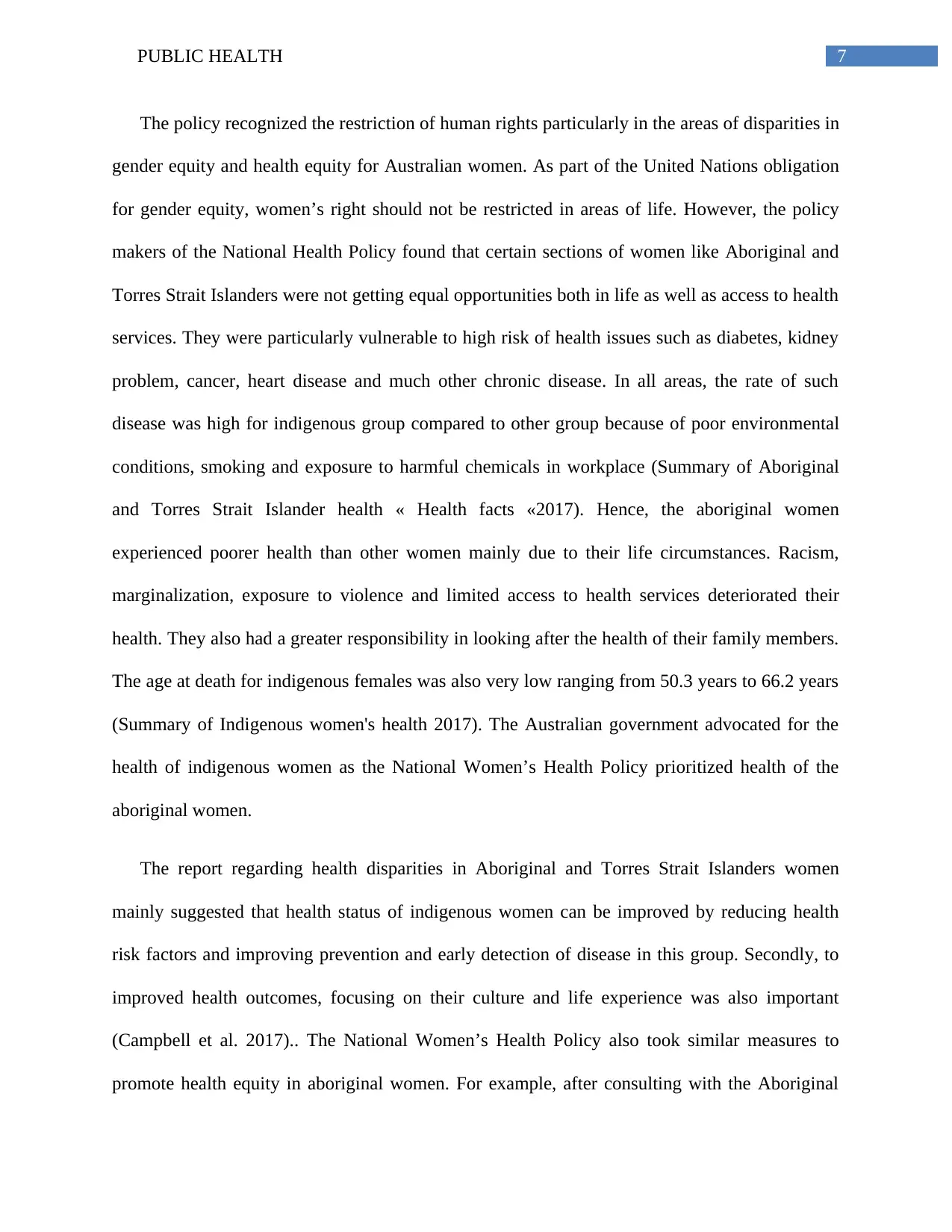
7PUBLIC HEALTH
The policy recognized the restriction of human rights particularly in the areas of disparities in
gender equity and health equity for Australian women. As part of the United Nations obligation
for gender equity, women’s right should not be restricted in areas of life. However, the policy
makers of the National Health Policy found that certain sections of women like Aboriginal and
Torres Strait Islanders were not getting equal opportunities both in life as well as access to health
services. They were particularly vulnerable to high risk of health issues such as diabetes, kidney
problem, cancer, heart disease and much other chronic disease. In all areas, the rate of such
disease was high for indigenous group compared to other group because of poor environmental
conditions, smoking and exposure to harmful chemicals in workplace (Summary of Aboriginal
and Torres Strait Islander health « Health facts «2017). Hence, the aboriginal women
experienced poorer health than other women mainly due to their life circumstances. Racism,
marginalization, exposure to violence and limited access to health services deteriorated their
health. They also had a greater responsibility in looking after the health of their family members.
The age at death for indigenous females was also very low ranging from 50.3 years to 66.2 years
(Summary of Indigenous women's health 2017). The Australian government advocated for the
health of indigenous women as the National Women’s Health Policy prioritized health of the
aboriginal women.
The report regarding health disparities in Aboriginal and Torres Strait Islanders women
mainly suggested that health status of indigenous women can be improved by reducing health
risk factors and improving prevention and early detection of disease in this group. Secondly, to
improved health outcomes, focusing on their culture and life experience was also important
(Campbell et al. 2017).. The National Women’s Health Policy also took similar measures to
promote health equity in aboriginal women. For example, after consulting with the Aboriginal
The policy recognized the restriction of human rights particularly in the areas of disparities in
gender equity and health equity for Australian women. As part of the United Nations obligation
for gender equity, women’s right should not be restricted in areas of life. However, the policy
makers of the National Health Policy found that certain sections of women like Aboriginal and
Torres Strait Islanders were not getting equal opportunities both in life as well as access to health
services. They were particularly vulnerable to high risk of health issues such as diabetes, kidney
problem, cancer, heart disease and much other chronic disease. In all areas, the rate of such
disease was high for indigenous group compared to other group because of poor environmental
conditions, smoking and exposure to harmful chemicals in workplace (Summary of Aboriginal
and Torres Strait Islander health « Health facts «2017). Hence, the aboriginal women
experienced poorer health than other women mainly due to their life circumstances. Racism,
marginalization, exposure to violence and limited access to health services deteriorated their
health. They also had a greater responsibility in looking after the health of their family members.
The age at death for indigenous females was also very low ranging from 50.3 years to 66.2 years
(Summary of Indigenous women's health 2017). The Australian government advocated for the
health of indigenous women as the National Women’s Health Policy prioritized health of the
aboriginal women.
The report regarding health disparities in Aboriginal and Torres Strait Islanders women
mainly suggested that health status of indigenous women can be improved by reducing health
risk factors and improving prevention and early detection of disease in this group. Secondly, to
improved health outcomes, focusing on their culture and life experience was also important
(Campbell et al. 2017).. The National Women’s Health Policy also took similar measures to
promote health equity in aboriginal women. For example, after consulting with the Aboriginal
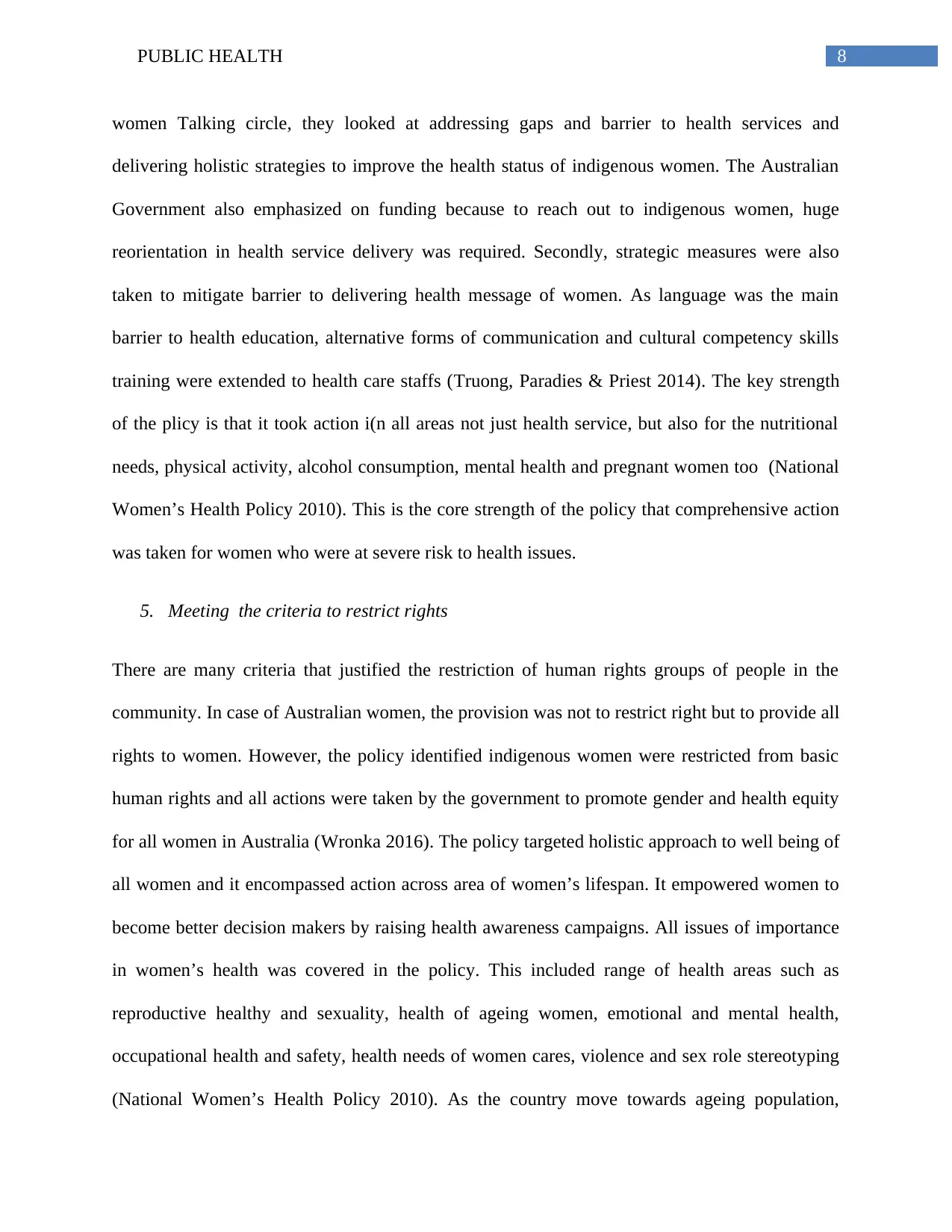
8PUBLIC HEALTH
women Talking circle, they looked at addressing gaps and barrier to health services and
delivering holistic strategies to improve the health status of indigenous women. The Australian
Government also emphasized on funding because to reach out to indigenous women, huge
reorientation in health service delivery was required. Secondly, strategic measures were also
taken to mitigate barrier to delivering health message of women. As language was the main
barrier to health education, alternative forms of communication and cultural competency skills
training were extended to health care staffs (Truong, Paradies & Priest 2014). The key strength
of the plicy is that it took action i(n all areas not just health service, but also for the nutritional
needs, physical activity, alcohol consumption, mental health and pregnant women too (National
Women’s Health Policy 2010). This is the core strength of the policy that comprehensive action
was taken for women who were at severe risk to health issues.
5. Meeting the criteria to restrict rights
There are many criteria that justified the restriction of human rights groups of people in the
community. In case of Australian women, the provision was not to restrict right but to provide all
rights to women. However, the policy identified indigenous women were restricted from basic
human rights and all actions were taken by the government to promote gender and health equity
for all women in Australia (Wronka 2016). The policy targeted holistic approach to well being of
all women and it encompassed action across area of women’s lifespan. It empowered women to
become better decision makers by raising health awareness campaigns. All issues of importance
in women’s health was covered in the policy. This included range of health areas such as
reproductive healthy and sexuality, health of ageing women, emotional and mental health,
occupational health and safety, health needs of women cares, violence and sex role stereotyping
(National Women’s Health Policy 2010). As the country move towards ageing population,
women Talking circle, they looked at addressing gaps and barrier to health services and
delivering holistic strategies to improve the health status of indigenous women. The Australian
Government also emphasized on funding because to reach out to indigenous women, huge
reorientation in health service delivery was required. Secondly, strategic measures were also
taken to mitigate barrier to delivering health message of women. As language was the main
barrier to health education, alternative forms of communication and cultural competency skills
training were extended to health care staffs (Truong, Paradies & Priest 2014). The key strength
of the plicy is that it took action i(n all areas not just health service, but also for the nutritional
needs, physical activity, alcohol consumption, mental health and pregnant women too (National
Women’s Health Policy 2010). This is the core strength of the policy that comprehensive action
was taken for women who were at severe risk to health issues.
5. Meeting the criteria to restrict rights
There are many criteria that justified the restriction of human rights groups of people in the
community. In case of Australian women, the provision was not to restrict right but to provide all
rights to women. However, the policy identified indigenous women were restricted from basic
human rights and all actions were taken by the government to promote gender and health equity
for all women in Australia (Wronka 2016). The policy targeted holistic approach to well being of
all women and it encompassed action across area of women’s lifespan. It empowered women to
become better decision makers by raising health awareness campaigns. All issues of importance
in women’s health was covered in the policy. This included range of health areas such as
reproductive healthy and sexuality, health of ageing women, emotional and mental health,
occupational health and safety, health needs of women cares, violence and sex role stereotyping
(National Women’s Health Policy 2010). As the country move towards ageing population,
⊘ This is a preview!⊘
Do you want full access?
Subscribe today to unlock all pages.

Trusted by 1+ million students worldwide
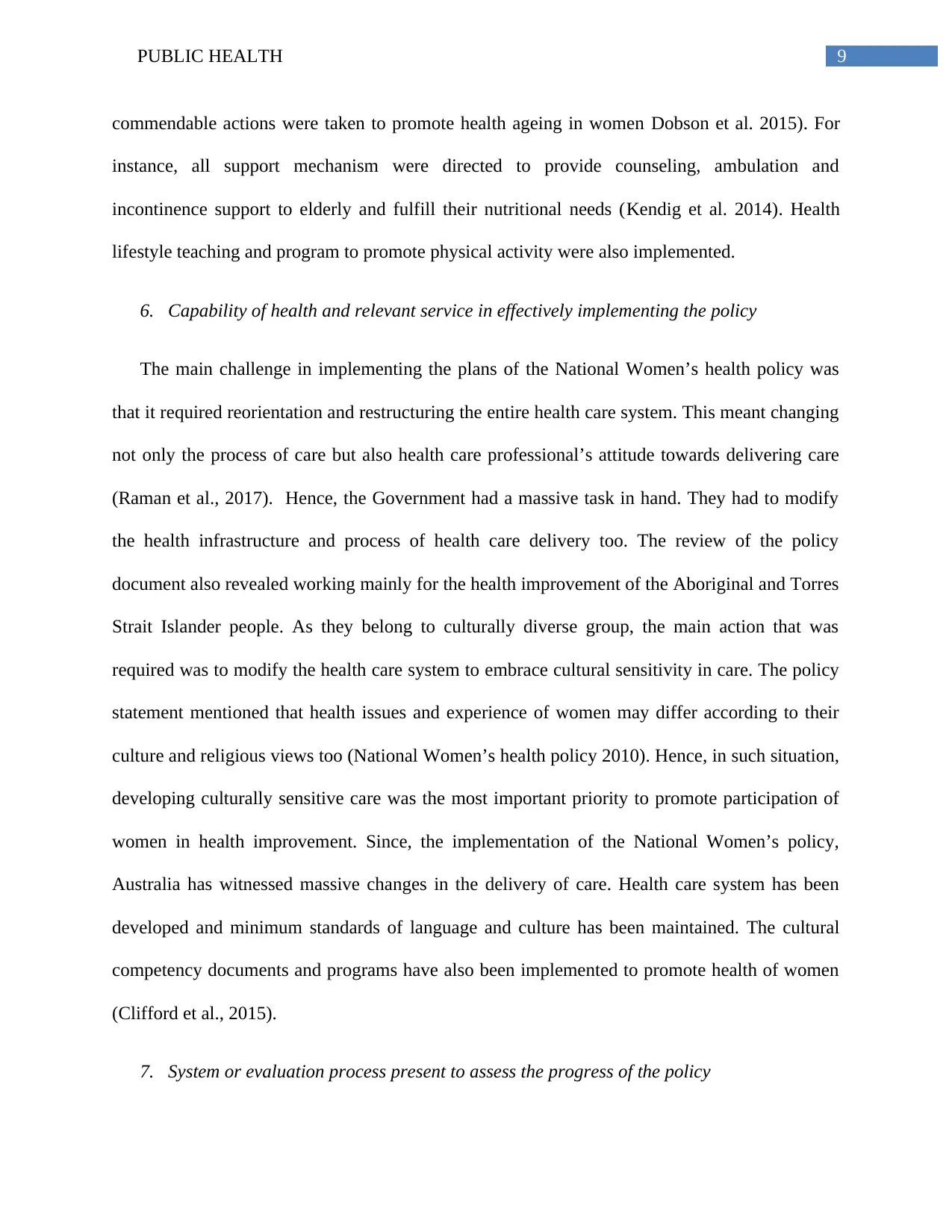
9PUBLIC HEALTH
commendable actions were taken to promote health ageing in women Dobson et al. 2015). For
instance, all support mechanism were directed to provide counseling, ambulation and
incontinence support to elderly and fulfill their nutritional needs (Kendig et al. 2014). Health
lifestyle teaching and program to promote physical activity were also implemented.
6. Capability of health and relevant service in effectively implementing the policy
The main challenge in implementing the plans of the National Women’s health policy was
that it required reorientation and restructuring the entire health care system. This meant changing
not only the process of care but also health care professional’s attitude towards delivering care
(Raman et al., 2017). Hence, the Government had a massive task in hand. They had to modify
the health infrastructure and process of health care delivery too. The review of the policy
document also revealed working mainly for the health improvement of the Aboriginal and Torres
Strait Islander people. As they belong to culturally diverse group, the main action that was
required was to modify the health care system to embrace cultural sensitivity in care. The policy
statement mentioned that health issues and experience of women may differ according to their
culture and religious views too (National Women’s health policy 2010). Hence, in such situation,
developing culturally sensitive care was the most important priority to promote participation of
women in health improvement. Since, the implementation of the National Women’s policy,
Australia has witnessed massive changes in the delivery of care. Health care system has been
developed and minimum standards of language and culture has been maintained. The cultural
competency documents and programs have also been implemented to promote health of women
(Clifford et al., 2015).
7. System or evaluation process present to assess the progress of the policy
commendable actions were taken to promote health ageing in women Dobson et al. 2015). For
instance, all support mechanism were directed to provide counseling, ambulation and
incontinence support to elderly and fulfill their nutritional needs (Kendig et al. 2014). Health
lifestyle teaching and program to promote physical activity were also implemented.
6. Capability of health and relevant service in effectively implementing the policy
The main challenge in implementing the plans of the National Women’s health policy was
that it required reorientation and restructuring the entire health care system. This meant changing
not only the process of care but also health care professional’s attitude towards delivering care
(Raman et al., 2017). Hence, the Government had a massive task in hand. They had to modify
the health infrastructure and process of health care delivery too. The review of the policy
document also revealed working mainly for the health improvement of the Aboriginal and Torres
Strait Islander people. As they belong to culturally diverse group, the main action that was
required was to modify the health care system to embrace cultural sensitivity in care. The policy
statement mentioned that health issues and experience of women may differ according to their
culture and religious views too (National Women’s health policy 2010). Hence, in such situation,
developing culturally sensitive care was the most important priority to promote participation of
women in health improvement. Since, the implementation of the National Women’s policy,
Australia has witnessed massive changes in the delivery of care. Health care system has been
developed and minimum standards of language and culture has been maintained. The cultural
competency documents and programs have also been implemented to promote health of women
(Clifford et al., 2015).
7. System or evaluation process present to assess the progress of the policy
Paraphrase This Document
Need a fresh take? Get an instant paraphrase of this document with our AI Paraphraser
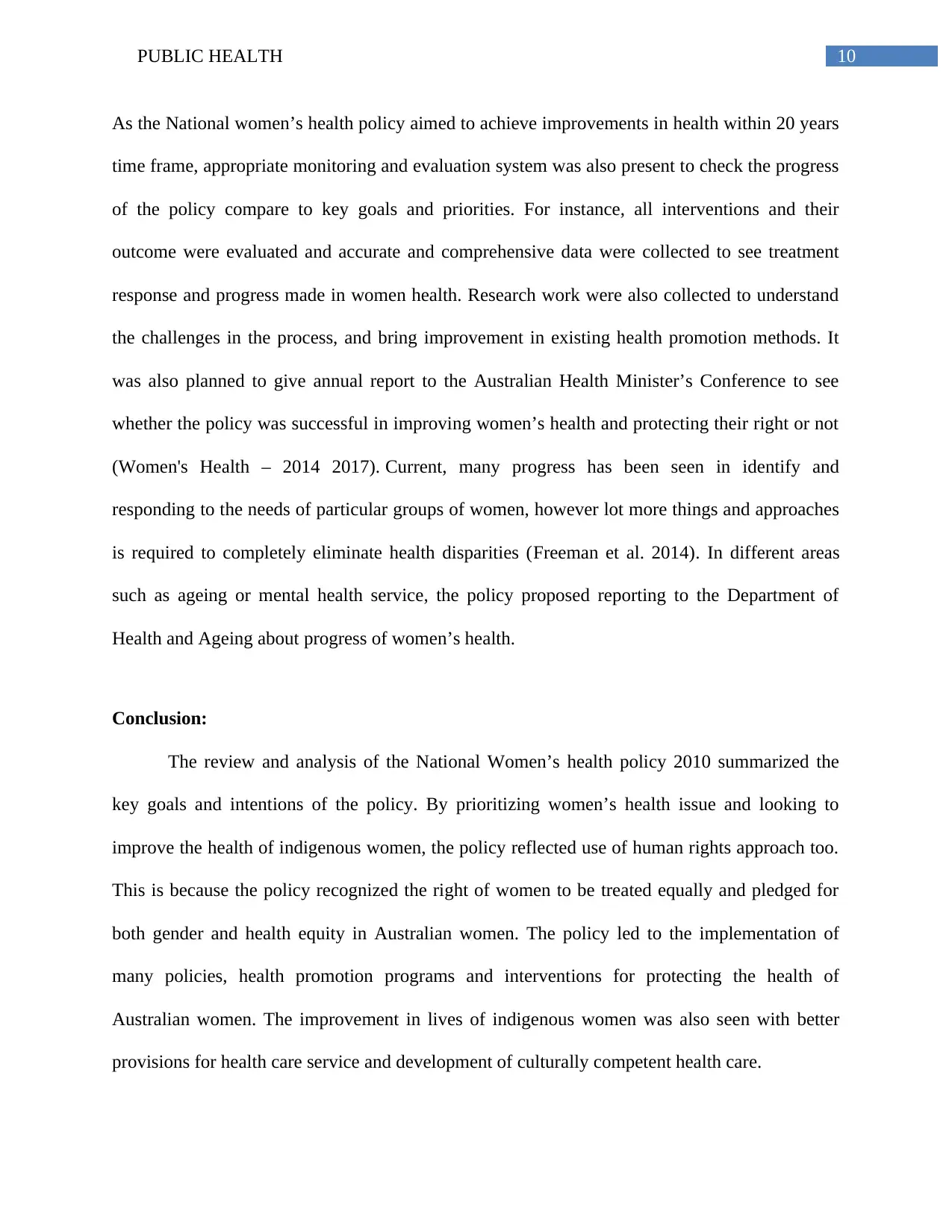
10PUBLIC HEALTH
As the National women’s health policy aimed to achieve improvements in health within 20 years
time frame, appropriate monitoring and evaluation system was also present to check the progress
of the policy compare to key goals and priorities. For instance, all interventions and their
outcome were evaluated and accurate and comprehensive data were collected to see treatment
response and progress made in women health. Research work were also collected to understand
the challenges in the process, and bring improvement in existing health promotion methods. It
was also planned to give annual report to the Australian Health Minister’s Conference to see
whether the policy was successful in improving women’s health and protecting their right or not
(Women's Health – 2014 2017). Current, many progress has been seen in identify and
responding to the needs of particular groups of women, however lot more things and approaches
is required to completely eliminate health disparities (Freeman et al. 2014). In different areas
such as ageing or mental health service, the policy proposed reporting to the Department of
Health and Ageing about progress of women’s health.
Conclusion:
The review and analysis of the National Women’s health policy 2010 summarized the
key goals and intentions of the policy. By prioritizing women’s health issue and looking to
improve the health of indigenous women, the policy reflected use of human rights approach too.
This is because the policy recognized the right of women to be treated equally and pledged for
both gender and health equity in Australian women. The policy led to the implementation of
many policies, health promotion programs and interventions for protecting the health of
Australian women. The improvement in lives of indigenous women was also seen with better
provisions for health care service and development of culturally competent health care.
As the National women’s health policy aimed to achieve improvements in health within 20 years
time frame, appropriate monitoring and evaluation system was also present to check the progress
of the policy compare to key goals and priorities. For instance, all interventions and their
outcome were evaluated and accurate and comprehensive data were collected to see treatment
response and progress made in women health. Research work were also collected to understand
the challenges in the process, and bring improvement in existing health promotion methods. It
was also planned to give annual report to the Australian Health Minister’s Conference to see
whether the policy was successful in improving women’s health and protecting their right or not
(Women's Health – 2014 2017). Current, many progress has been seen in identify and
responding to the needs of particular groups of women, however lot more things and approaches
is required to completely eliminate health disparities (Freeman et al. 2014). In different areas
such as ageing or mental health service, the policy proposed reporting to the Department of
Health and Ageing about progress of women’s health.
Conclusion:
The review and analysis of the National Women’s health policy 2010 summarized the
key goals and intentions of the policy. By prioritizing women’s health issue and looking to
improve the health of indigenous women, the policy reflected use of human rights approach too.
This is because the policy recognized the right of women to be treated equally and pledged for
both gender and health equity in Australian women. The policy led to the implementation of
many policies, health promotion programs and interventions for protecting the health of
Australian women. The improvement in lives of indigenous women was also seen with better
provisions for health care service and development of culturally competent health care.
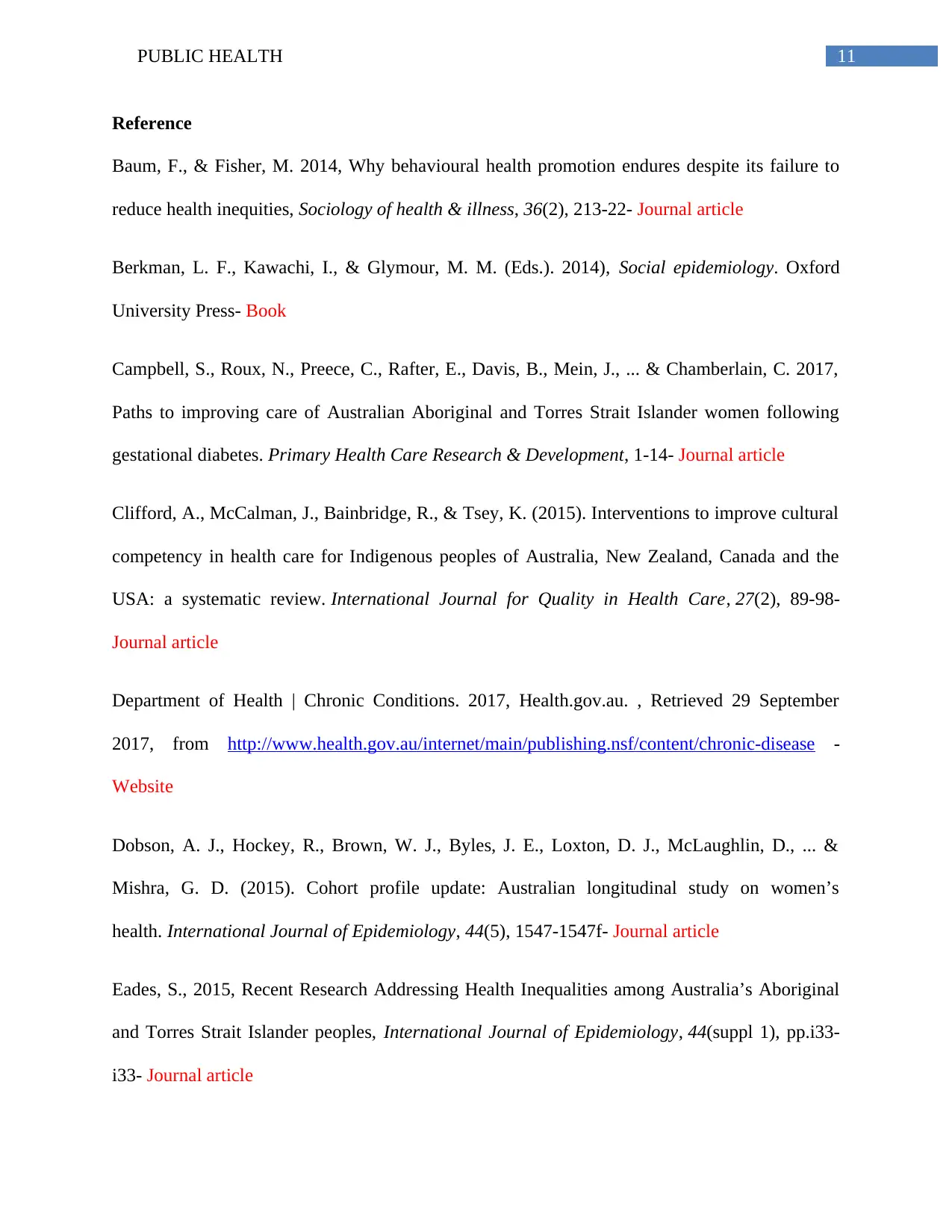
11PUBLIC HEALTH
Reference
Baum, F., & Fisher, M. 2014, Why behavioural health promotion endures despite its failure to
reduce health inequities, Sociology of health & illness, 36(2), 213-22- Journal article
Berkman, L. F., Kawachi, I., & Glymour, M. M. (Eds.). 2014), Social epidemiology. Oxford
University Press- Book
Campbell, S., Roux, N., Preece, C., Rafter, E., Davis, B., Mein, J., ... & Chamberlain, C. 2017,
Paths to improving care of Australian Aboriginal and Torres Strait Islander women following
gestational diabetes. Primary Health Care Research & Development, 1-14- Journal article
Clifford, A., McCalman, J., Bainbridge, R., & Tsey, K. (2015). Interventions to improve cultural
competency in health care for Indigenous peoples of Australia, New Zealand, Canada and the
USA: a systematic review. International Journal for Quality in Health Care, 27(2), 89-98-
Journal article
Department of Health | Chronic Conditions. 2017, Health.gov.au. , Retrieved 29 September
2017, from http://www.health.gov.au/internet/main/publishing.nsf/content/chronic-disease -
Website
Dobson, A. J., Hockey, R., Brown, W. J., Byles, J. E., Loxton, D. J., McLaughlin, D., ... &
Mishra, G. D. (2015). Cohort profile update: Australian longitudinal study on women’s
health. International Journal of Epidemiology, 44(5), 1547-1547f- Journal article
Eades, S., 2015, Recent Research Addressing Health Inequalities among Australia’s Aboriginal
and Torres Strait Islander peoples, International Journal of Epidemiology, 44(suppl 1), pp.i33-
i33- Journal article
Reference
Baum, F., & Fisher, M. 2014, Why behavioural health promotion endures despite its failure to
reduce health inequities, Sociology of health & illness, 36(2), 213-22- Journal article
Berkman, L. F., Kawachi, I., & Glymour, M. M. (Eds.). 2014), Social epidemiology. Oxford
University Press- Book
Campbell, S., Roux, N., Preece, C., Rafter, E., Davis, B., Mein, J., ... & Chamberlain, C. 2017,
Paths to improving care of Australian Aboriginal and Torres Strait Islander women following
gestational diabetes. Primary Health Care Research & Development, 1-14- Journal article
Clifford, A., McCalman, J., Bainbridge, R., & Tsey, K. (2015). Interventions to improve cultural
competency in health care for Indigenous peoples of Australia, New Zealand, Canada and the
USA: a systematic review. International Journal for Quality in Health Care, 27(2), 89-98-
Journal article
Department of Health | Chronic Conditions. 2017, Health.gov.au. , Retrieved 29 September
2017, from http://www.health.gov.au/internet/main/publishing.nsf/content/chronic-disease -
Website
Dobson, A. J., Hockey, R., Brown, W. J., Byles, J. E., Loxton, D. J., McLaughlin, D., ... &
Mishra, G. D. (2015). Cohort profile update: Australian longitudinal study on women’s
health. International Journal of Epidemiology, 44(5), 1547-1547f- Journal article
Eades, S., 2015, Recent Research Addressing Health Inequalities among Australia’s Aboriginal
and Torres Strait Islander peoples, International Journal of Epidemiology, 44(suppl 1), pp.i33-
i33- Journal article
⊘ This is a preview!⊘
Do you want full access?
Subscribe today to unlock all pages.

Trusted by 1+ million students worldwide
1 out of 15
Related Documents
Your All-in-One AI-Powered Toolkit for Academic Success.
+13062052269
info@desklib.com
Available 24*7 on WhatsApp / Email
![[object Object]](/_next/static/media/star-bottom.7253800d.svg)
Unlock your academic potential
Copyright © 2020–2025 A2Z Services. All Rights Reserved. Developed and managed by ZUCOL.





